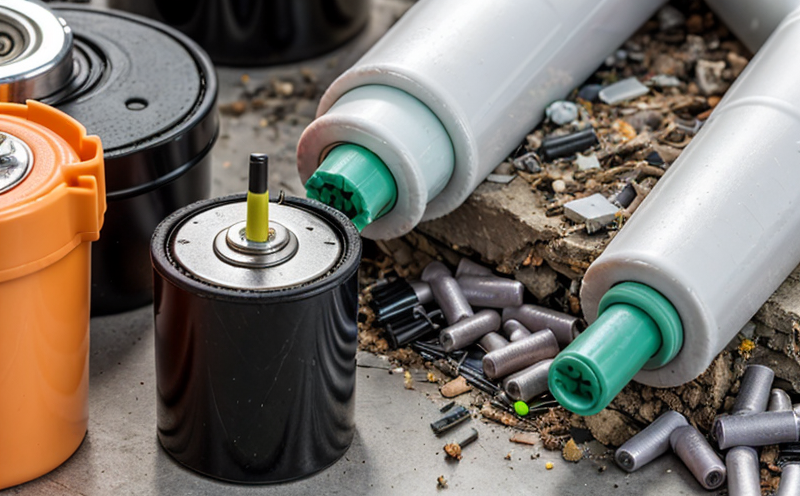ANSI C18.3M End-of-Life Testing of Button Cell Batteries
The ANSI C18.3M standard is a critical document that outlines the end-of-life testing requirements for button cell batteries. This service, provided by our accredited laboratory, ensures compliance with industry standards and regulatory requirements while offering valuable insights into the performance and safety of these batteries at their lifecycle's final stages.
Button cell batteries are widely used in various portable electronic devices such as watches, medical implants, and remote controls. As they reach end-of-life, it is essential to understand their remaining capacity, leakage potential, and overall integrity before disposal or recycling. Our ANSI C18.3M testing ensures that these batteries meet stringent quality and safety standards, thereby promoting responsible waste management practices.
The testing process involves several key steps. Specimens are first selected based on the standard's criteria to ensure a representative sample set. These specimens undergo various tests including leakage detection using specialized equipment like pressure vessels designed for this purpose. Voltage measurements are taken throughout the test duration to assess remaining capacity accurately.
Another crucial aspect of end-of-life testing is determining whether the battery poses any risk during disposal or recycling processes. This evaluation includes assessing chemical composition and identifying hazardous materials that need special handling procedures. By providing comprehensive data on these aspects, our ANSI C18.3M test results enable manufacturers to make informed decisions about how best to manage their batteries responsibly.
The importance of this testing cannot be overstated in today's environmentally conscious world where proper disposal methods play a significant role in minimizing environmental impact. Our laboratory adheres strictly to the procedures outlined in ANSI C18.3M, ensuring accurate and reliable results every time. This level of precision is crucial given the potential health risks associated with improperly handled button cell batteries.
In summary, ANSI C18.3M end-of-life testing offers more than just compliance; it provides valuable information that can inform future design improvements or changes in production processes. It also helps businesses comply with increasingly stringent regulations around hazardous waste management while fostering sustainable practices within the industry.
Scope and Methodology
The scope of ANSI C18.3M end-of-life testing includes assessing various characteristics of button cell batteries that are critical for understanding their remaining performance capabilities and safety profiles at the end of their useful life cycles. The methodology typically involves several stages:
- Sample selection: Carefully choosing battery units representative of the batch being tested.
- Leakage detection: Using pressurized containers to identify any leaks that could pose environmental or health risks.
- Voltage measurement: Monitoring voltage levels over time to gauge remaining capacity accurately.
- Hazard identification: Analyzing components for hazardous materials and determining appropriate disposal methods.
Each stage is conducted meticulously following the guidelines set forth by ANSI C18.3M, ensuring accurate results that are both reliable and reproducible.
Why Choose This Test
- Compliance Assurance: Ensures adherence to international standards like ANSI C18.3M, which is crucial for regulatory compliance.
- Risk Mitigation: Identifies potential risks associated with improper disposal or recycling of button cell batteries.
- Sustainability: Promotes responsible waste management practices by providing data on battery composition and hazards.
- Informed Decision-Making: Provides valuable insights that can guide future product development and operational strategies.
- Reputation Enhancement: Demonstrates commitment to environmental responsibility, which is increasingly important for brand reputation.
- Cost Efficiency: Helps avoid costly mistakes by identifying issues early in the lifecycle of a product or process.
By choosing our ANSI C18.3M end-of-life testing service, you gain access to expertly conducted tests that meet stringent quality standards and provide actionable insights into your battery products' performance and safety at their final stages.
Competitive Advantage and Market Impact
The ANSI C18.3M end-of-life testing service offers several competitive advantages to businesses in the battery industry:
- Differentiation: By demonstrating a commitment to environmental stewardship, your company can differentiate itself from competitors.
- Increased Customer Confidence: Meeting or exceeding international standards builds trust among consumers and stakeholders.
- Early Issue Detection: Identifying potential problems early helps prevent costly recalls and repairs downstream in the supply chain.
- Regulatory Compliance: Ensuring compliance with all relevant regulations reduces legal risks associated with non-compliance.
- Better Resource Allocation: Data from these tests can help optimize resource allocation by focusing efforts on areas where improvements are needed most.
- Enhanced Reputation: Companies that prioritize sustainability often see increased market share due to positive public perception.
In today's marketplace, companies that lead in environmental responsibility are more likely to succeed. Our ANSI C18.3M testing service provides the tools needed to stay ahead of competitors and maintain a strong market position.





